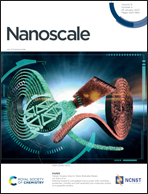Strain-induced magnetic phase transition, magnetic anisotropy switching and bilayer antiferromagnetic skyrmions in van der Waals magnet CrTe2†
Abstract
In recent years, considerable attention has been paid to the research of peculiar magnetism in two-dimensional (2D) van der Waals (vdW) layered materials. Here, we unveil the major features and deep physical mechanisms of a magnetic phase transition and magnetic anisotropy switching in monolayer CrTe2 and antiferromagnetic (AFM) skyrmions in bilayer CrTe2via first-principles calculations and micromagnetic simulations. We find that a magnetic phase transition from stripy-type AFM to ferromagnetic (FM) order can be induced by applying a tensile strain of 3%. More interestingly, the magnetic easy axis can be switched between in-plane and off-plane via adjusting the magnitude of strain. Besides, the topologically protected bilayer AFM skyrmion is stabilized by a large Dzyaloshinskii–Moriya interaction (DMI) of 1.43 meV and a skyrmion lattice can be induced by a magnetic field of 6.9 T at 100 K. Different from the monolayer magnetic skyrmion, the bilayer AFM skyrmion is more promising in spintronic nanodevices owing to the suppressed skyrmion Hall effect. Our findings clarify the underlying mechanisms of the strain-tunable magnetic phase transition, magnetic anisotropy switching and bilayer AFM skyrmions in vdW magnet CrTe2, and also highlight the promising applications of CrTe2 in next-generation information storage devices.



 Please wait while we load your content...
Please wait while we load your content...